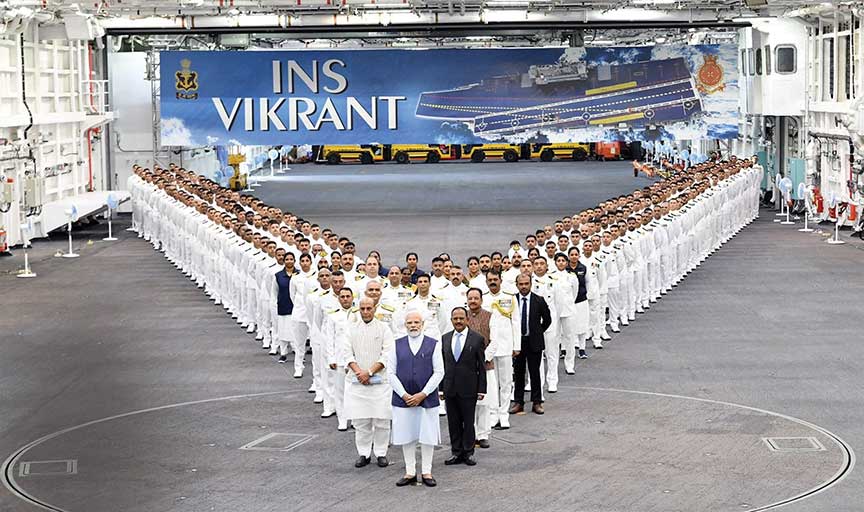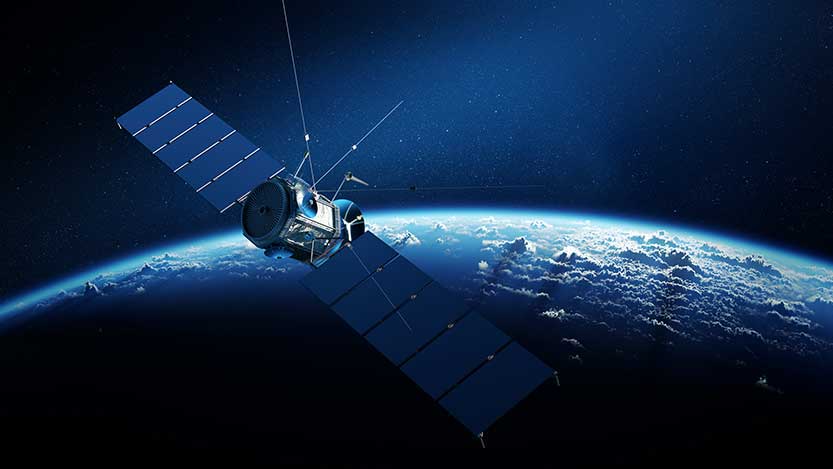
On 2nd September 2022, Prime Minister Narendra Modi commissioned India’s first 40,000 ton Stobar (short take off from the 160m deck and three-barrier assisted landing) aircraft carrier INS Vikrant at the Cochin Shipyard Ltd (CSL). Vikrant was made and designed in India by the Navy’s Warship Design Bureau. Earlier in 2016, the Navy commissioned 6,300 ton nuclear powered SSBN INS Arihant, also made in India with the 750km range nuclear-tipped K-15/B-05 missiles at the DRDO’s Shipbuilding Centre (SBC) in a Public Private Partnership with Larsen & Toubro Ltd (L&T) at the sprawling Naval Dockyard in Visakhapatnam with an Indian BARC-DAE nuclear power plant. These are landmark achievements for India’s manufacturing ecosystem, that the Navy has contributed.
The Navy strived to make in India since it commissioned a 3,000 ton Leander in 1972. Soon it will commission the second 7,200 ton Type 15B Mormugao destroyer with the 650 km BrahMos NG and Barak-8 made in India and Vagir the fourth Scorpene both from Mazagon Docks Shipbuilding Ltd (MDSL) at Mumbai. Type 15B is named after the Indian states of Andhra and Goa and to follow will be Imphal in Manipur and Surat in Gujarat. The nation must appreciate the Navy@75’s Amrit Mahatsov, how this small silent service of 65,000 uniformed men and now women has done a little better than the other two services to help itself with low budgets. The Navy’s emphasis has been on high standards of training with no compromises, induction of the latest technology and selection and fitting of best available hardware and software from local sources and abroad by cutting its coat to the cloth it gets in budgets and setting lofty goals.
Naval architects
Much credit goes to the Navy’s Directorate of Naval Design (DND) set up in Greater Kailash in the 1950s manned by a Corps of Naval Constructors and set up WESO with few officers under Cdr JJ Baxi, later the Weapons Electrical and Systems Engineering Establishment (WESEE) to support DND in Civil Lines and then RK Puram. DND has expanded into two large groups of naval architects. One group designs and upgrades the complete range of all Surface ships housed in a civilian building in Kailash Colony, and another Submarine group of constructors and multi-discipline officers in RK Puram’s Defence Complex and caters to submarine designs and modifications, which takes place every ten years called mid-life refits. Currently, Kilo-class submarines and the three B’putras and three Russian 1136.5 Krivacks are in line for mid-life refits. The debate is on whether to refit the Kilos in India or at Sevmash Zhdovachka in Russia.
The Navy’s budgets were lowest and waxed and waned (8 to 15% of the Defence Budget) but India’s Navy grew with self-help. Naval officers and artificers who brought back ships from shipyards in the UK in the 1960s need recalling for their foresight and planning. The constructors trained in IIT Kharagpur and abroad at RNEC Plymouth, Cranfield Institute of Technology, Royal Naval College at Greenwich and the Grechko and Krylov Research Institutes in the Soviet Union need mention @75. They created a shipbuilding ecosystem over time for four government shipyards and a Shipbuilding Centre (SBC) at Visakhapatnam with Naval officers as heads and retired naval personnel working in public sector shipyards and two large private shipyards. India’s PSU and few civil shipyards have, to date, delivered over 120 ships ranging from the small dockyard and basic patrol boats and amphibious ships to sophisticated submarines, frigates and destroyers, and an Aircraft Carrier.
WESEE from specifying system requirements for ships, it has designed the architecture of EW, Command and Control (CIC) systems, Naval Wide Communication Networks including for VSAT and the GSAT 7 satellite. WESEE has designed sonars, selected modems with civil firms for Link 1 and 2 and Satellite systems and provided cyber solutions and handled many classified and crypto programmes. With the acquisition of coherent computers and software programmes available in the market WESEE designs detailed circuits for solutions for command management systems. A separate group was formed called the networking group ideal for Network Centric Operations to connect 11 headquarters including the Coast Guard for Maritime Domain Awareness (MDA). WESEE is the first defence organisation to achieve CMMI Maturity Level 3 Rating for software development and maintenance projects cooperating with DRDO in laboratories and private software and technology firms like INFOSYS and WIPRO on the principle warfare and technology are almost synonymous, as one drives the other. Navy’s technical officers are M-Tech passed in naval subjects in IITs or institutions.
DRDO, Bharat Electronics Ltd and Electronics Corporation of India Ltd (ECIL) began to deliver sonars, communication systems and fuzes and private companies like L&T and TATAs and Mahindra’s with sea mines joined. In manufacturing, with pharma and car manufacturing the Navy can be called the catalyst of India’s manufacturing potential and exports, in the author’s view. India already leads in software exports.

Operator maintainer policy
Naval officers closely follow the wide-ranging advances in technology taking place and the revolution in Naval and Submarine Technologies and Systems and maintenance and long-term support. The Navy adopted an operator maintainer policy and exploited a life-cycle management methodology. Admiral SM Nanda as ASD made Commanders of departments General Managers after a study. It paid dividends. The Navy loaned the Naval Dockyard computer (the military’s first) in Bombay at night for use by International Computers Ltd (ICL Ltd), which gave the Navy early experience in computer technology.
The first lot of specialised submarine architects were trained at Ingenieur Kontor Lübeck (IKL) in Germany headed by Ulrich Gabler who was considered one of the best designers in the world for conventional submarines. They brought back over 20,000 drawings and stability calculations and the two HDW-1400 submarines were successfully built at Mazagon Docks Ltd (MDL) and are still operational. This has paid dividends as Herr Gabler took a personal interest in their training. As a self-goal, the project was suspended.
DND groups are electronically inter-linked 24X7 with secure internet protocols (by WESEE) with PSU shipyards, namely Mazagon Docks and Shipbuilders Ltd (MDSL), Garden Reach Shipbuilders and Engineers Ltd (GRSE), Goa Shipyard Ltd (GSL) and Cochin Shipyard Ltd (CSL) and also with the classified nuclear Submarine Building Centre (SBC) at Visakhapatnam on ‘need to know basis’. SBC was carved out of the sprawling Naval Dockyard in 1990. ND(V) was built in the 1970s, with Soviet drawings and help and as Admiral Gorshkov took a deep interest he took when he visited Visakhapatnam. He was hoping to base Soviet ships there as it had a Kremlin Hostel for Russians in the Cold War days, but Mrs Indira Gandhi politely did not allow it.
Large water tanks
Ships do not have prototypes like tanks or planes to experiment with. DND’s models were tested in large water tanks at MARIN in the Netherlands. Today DND is replete with desktop workstations with computer-based CAD-CAM and virtual systems that allow one to walk around for ergonomic checks and even operate dummy systems, a boon of technology. The Naval Science and Technology Laboratory (NSTL) at Visakhapatnam has a testing tank and associated facilities for ship designs and DRDO’s Defence Research and Material Laboratory (DMRL) is at Ambernath near Mumbai is designing an Air Independent Propulsion (AIP) while Defence Machinery Development Establishment (DMDE) in Secunderabad tests machinery for ships, submarines especially nuclear before fitting.
The Indian Navy’s management of the service is like a corporation with best practices as is its hallmark. Macro management and financial planning are done from Naval Headquarters and precise policy directions are issued by the Chief of the Naval Staff (CNS) and the four Principal Staff Officers (VCNS for acquisitions and policy, DCNS for Operations, Intelligence and Aviation, COP for HR, personnel and morale, and COM for Electronics, Engineering and Ship Building).
These directions are sent in clear terms to the three C-in-Cs in the West at Mumbai, East at Visakhapatnam and South for training to micro-manage without interference. Classified War orders are kept up to date for C-in-Cs to exercise Fleets for war without giving away the manner the Navy will operate to the enemy, with the lessons learnt from its victorious contribution in the 1971 war. Policies are tweaked in regular Commander’s Conferences where all Directors are encouraged to attend and contribute. An annual training and refit conference is held for the review and planning of the year so targets are clear down the line.

In days of yore communications at sea were slow with HF wireless and compete for leeway to act with an initiative to serve the nation’s best interests. All navies in the world operate with the delegation of powers to their ships’ Captains at sea. Soon after the Internet revolution, the Navy was the first to induct the GSAT 7 satellite made by ISRO, with Rukmani communication systems.
PM Narendra Modi spoke at the exclusive Naval seminar, titled ‘Swavlamban’ (self-reliance) on 18th July 2022 and congratulated the Navy’s efforts and described the goal of self-reliance in the Indian defence forces. “In the past four-five years, the defence imports have come down by 21 per cent. Today, we are moving fast to be a big exporter. Last year, Rs 13,000 crore worth of defence export was made.” At ‘Swavlamban’, Vice Admiral SN Ghormade, Vice Chief of Naval Staff, touched on India’s Blue economy and the Navy’s acquisition of around 38 platforms on order and other programmes. Jayant Patil, head of the Society of Indian Defence Manufacturers (SIDM), provided the industry perspective. On 4th December this year, the Navy will celebrate its Navy Day and look back with pride but its motto is to set lofty goals. Shan No Varuna!
–The writer is an Indian Navy veteran, former DNO and DNI. He writes and broadcasts on military affairs and is Curator of New Delhi’s only Maritime Museum at C 443 Defence Colony with free entry to bring about Sea Mindedness. The views expressed are personal and do not necessarily reflect the views of Raksha Anirveda








